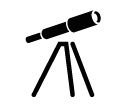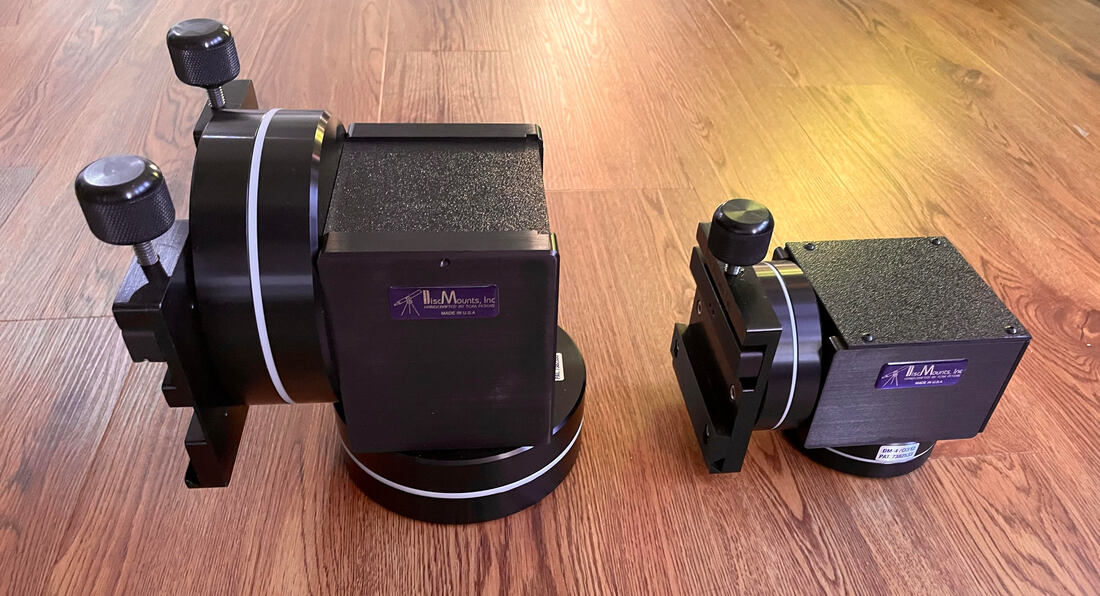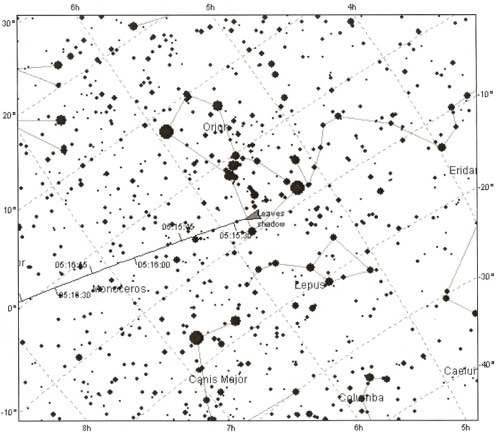|
The sky is clear this week, but I can't go out every night - with two kids, I just don't have the stamina - so I figured I'd write some reflections on the astronomical accessories that have made an impression over the years, good or bad. Because I have to walk to my observing sites and because, as a father with a demanding job, I don't usually have much time to observe, the equipment that works best for me might not work as well for everyone - and the same applies for the stuff I didn't like. Still: some thoughts. The good stuffOrion 6x30 right-angle finder I've used countless finders over the years. There were red dot finders from Baader, Celestron, and Riger; there were finder scopes from Celestron, Skywatcher, Explore Scientific, Orion, and Takahashi. Of all the finders that have graced my telescopes, this is by far the best. It's lightweight. It's easy to mount. It doesn't hurt my neck. The field of view is just the right width. The optical quality is good enough to get the job done. And most importantly, I can always align it within moments. The adjustment screws are a snap to use, and so well placed. I'll admit: I don't love the dew caps - they can be a little dicey to remove - but everything else is just about perfect. Any Berlebach tripod If you need a tripod for your telescope, these are the ones to get. They're made of beautiful wood that simply does not get scuffs or scratches, so it always looks new. The build quality is incredible. They're a little heavier than some metal equivalents - especially if the metal is carbon fiber - but they absorb vibrations very well, and are therefore more stable than other tripods. What's not to like? TeleVue Delos eyepieces I've used just about every kind of TeleVue eyepiece over the years, from relatively inexpensive Plossls (see below) to the flagship Ethos brand. To my mind, the Delos eyepieces are the best of the lot. The eye relief is great, the contrast impeccable, and the field of view is wide and flat. The difference in contrast between the also-excellent Nagler eyepieces and the Delos line is subtle but definitely noticeable on, for example, Jupiter and Mars. The only downside is that the Delos eyepieces are heavy, and therefore not exactly transportable. TeleVue Nagler 3-6mm zoom eyepiece This is my favorite Nagler eyepiece. The contrast is nearly as good as I get with the Delos eyepieces, yet it's much lighter and it toggles effortlessly between magnifications. I make sure to always have it around when the seeing promises to be good, and I can crank up the magnification on the refractors. TeleVue Plössl eyepieces They're not super pricey, but oh so much better than anything you can buy from a lesser manufacturer. Their contrast rivals that of the Delos eyepieces, but the field of view is narrower, and there's definite field curvature at edge of view. If your target is relatively small and you can keep it centered, these eyepieces offer incredible value. TeleVue Everbrite diagonals I really love these things, in both the 1.25" and 2" models. They're made from a solid hunk of metal, and they always seem to give me cool, bright views. Their clamping screws are oversized and a breeze to use in any weather. Baader 2” BBHS Sitall Mirror Diagonal As good as the Everbrite diagonals may be, the premium competition from Baader is generally regarded as just a touch better. I have to confess that I've never noticed a clear difference optically, and that I prefer the mechanical quality of the TeleVue diagonals. Yet the clicklock feature of the Baader variants is just such an improvement over anything else out there. The last thing you want to do in the darkness is mess with screws; Baader removes that necessity. For a sky-high price, of course. DiscMounts DM-6 This is a huge hunk of metal: like a miniature Borg cube, and no less threatening when you face the prospect of hauling it to a park in a backpack. I like my mounts to weigh substantially less than my telescopes - ideally less than half as much - whereas the weight of the DM-6 approaches that of my largest telescope. And yet: it's a beautifully crafted manual mount. You can just feel the attention to detail that has gone into its design and construction. Tracking the planets at around 200x is so easy and smooth with this mount, and it's a snap to adjust its tension to make it smoother still. So it's painful to transport, but a joy when set up. DiscMounts DM-4 It's much smaller than the DM-6, but made with equal care and precision. Once again, the mount-weight to telescope-weight ratio isn't ideal. This mount barely handles my Takahashi FC-100DZ. Yet it slips easily into a backpack or suitcase. Easier to transport, and a bit less joyful to use. ORCA OR-732 Hexagon Soft Tripod/Light Stand Bag Since I have to walk a ways to get to my observing spots, I really care about lightweight carrying cases. For my mid-sized tripods, this is the best I've found. It's very well made, comfortable to carry, heavily padded, and (somehow) quite light. Oh, and it's durable, which can't be said about every carrying case. Pacific Design Soft Case These carrying cases are incredible for catadioptric telescopes, especially a C8. They fit snugly, are extremely lightweight, and are just perfect to carry. They make an already portable telescope that much easier to transport . . . though I confess that they don't seem to have a whole lot of padding. Mixed feelingsAYO II and VAMO Traveler mounts This is a tough one. Both mounts are beautifully made and, unlike their DiscMounts competition, remarkably lightweight compared to the telescopes they can carry. At just three pounds, the Traveler held my C8 with no problems, though the FC-100DC was a little shaky on a breezy night. At around six pounds, the AYO II carried my APM 140 - not easily, but well enough to allow high-power planetary observation. On paper, that should make these mounts hard to beat. Yet the Traveler arrived with a malfunction - I could never adjust a knob to control the tension of its horizontal axis - and, after just a year, the AYO II developed unacceptable slippage in its vertical movements. At that point, it was essentially useless to me. Add to that the paint chips that started chipping off the mount, and my initially extremely favorable impressions quickly soured. These mounts are really expensive, and deploy really simple technology. They should last longer than a year. Explore Scientific Twilight mounts I bought this mount and tripod combination twice. Both times, I really enjoyed its relatively light weight, and its slow-motion knobs. Both times, magnets holding an Allen key to the mount - which you can use to adjust the angle head - simply fell off. The slow-motion knobs did, too. One mount I bought didn't allow me to adjust the angle head at all; the other did. Explore Scientific, in my experience, has quality control problems. Explore Scientific 82° eyepieces These were my bridge from the realm of cheap eyepieces to the hallowed ground of TeleVue. Yes, they were clearly superior to the Celestron Plössl eyepieces that ship with telescopes. Yet I didn't find the view as crisp and clear as those I get with my Delos eyepieces, for example. They're also less than half the cost of those eyepieces, so you do get what you pay for. Neewer 44 inches Rolling Camera Case This gigantic rolling case is almost great. It used to hold my APM 140, AYO II mount, eyepieces, finder, and stool. Now it holds my Berlebach Uni tripod instead of my TEC 140, which I carry. It's almost great because its handle is way too short, which means it's awkward and heavy to transport for more than a few minutes, and it doesn't seem to have any shock absorption, despite Neewer's promise of an "anti-shock padded compartment." I would gladly buy this case again - I couldn't imagine hauling a big refractor to a park without it - I just wish it was a little more optimized for my needs. Universal Astronomics MacroStar Deluxe I've owned two Universal Astronomics mounts, and this was the best by far. It was surprisingly lightweight for a mount that can hold a 10" Schmidt–Cassegrain, and it seemed really solidly made. Yet it had a little too much resistance - movements were not perfectly smooth, even with my 8" Edge HD - and there was something a little rough about its build quality. The optional eyepiece tray that I got with it also had razor-sharp edges that threatened to decapitate me in the darkness, which is usually not ideal. Skywatcher AZ GTI It's lightweight! Yet it requires eight (!) AA batteries - no rechargeable lithium here - and it's noisy as it slews to its targets. Instructions are totally inadequate, and the software seems years out of date. Plastic parts galore reflect mediocre build quality. Lots of people like this mount; spoiled by premium manual mounts, I did not. DisappointingCelestron Eyepiece and Filter Kit I imagine a lot of people buy this kit when first getting started, and I was no exception. I wanted more magnification from my telescope - surprise, surprise - and I convinced myself that filters would help me see planetary detail. Trouble is: most of these simple Plössl eyepieces have such small focal lengths and terrible eye relief that they're almost impossible to look through. Otherwise the quality of the eyepieces is mediocre at best, and the quality of the filters is even worse. As soon as you realize that quality eyepieces exist, you want nothing to do with these. And then you're out about $150, because this thing is not easy to sell for much on the used market. Seasoned observers know exactly what it is: a trap for the inexperienced. Takahashi 6x30 finderscope and bracket This is blasphemy, I know. The Takahashi 6x30 finders are generally regarded as among the best - perhaps the best - on the market. And yes, the optical quality is superb. But it's so easy to scratch the paint job using the bracket, which is a pain to adjust and must be unscrewed to remove from the optical tube assembly. Straight-through finders also hurt my neck. But more importantly: do you really need to pay a premium for a finder that has optical quality to match your fine refractor? In my experience, the answer is no. Takahashi Extender-Q 1.6X As I chronicle in these pages, I once had an FC-100DC. By reading entirely too many forum posts and reviews - on CloudyNights, for example - and by observing during a stretch of mediocre seeing, I came to the conclusion that I could meaningfully improve its planetary performance by buying this little gadget . . . for a cool $600. When it arrived, I found a way to screw it in despite typically terrible Takahashi instructions. For a while I convinced myself that it really did improve my views of Jupiter or Mars, except it lengthened my telescope, altered its center of gravity, and generally made it excessively wobbly on a light mount and tripod. I struggled with that as best I could, until one day it dawned on me - partly by reading this journal - that I really couldn't see noticeably more than I could without the extender. So I sold it. The biggest issue in the end was that the telescope already worked perfectly well without the extender. Sometimes the urge to see just a little bit more is a fool's errand. Universal Astronomics Medium Tripod More blasphemy! Universal Astronomics used to make some of the best manual mounts around. But this tripod was all creaky, heavy aluminum that quickly developed signs of wear and tear. It wasn't all bad - it was stable and the built-in carrying strap was great - but give me wooden tripods, please. Vixen Optics Star Guy Telescope Case SGC10 This is an exceptionally well-made carrying case for a catadioptric telescope. It is also comically heavy. If all you want to do is move your telescope a few steps from the garage to the backyard, fine. If you want to actually carry a Mewlon 180, for example, for more than a few steps . . . well, you might as well transport a C11. It's that heavy. More concluding thoughts. In this hobby, I've consistently lost money by buying something that was good but not great; deciding I really did need or want something great; and then selling that good item at a loss to finance the great item I should have bought in the first place. Perhaps that's just my personality, though this hobby can lend itself to perpetual discontentedness with the equipment you already have. There always seems to be something a little better around the corner.
To that end, I've also lost money by buying what I thought I might be able to use someday, rather than what I knew I could use right now. That has always, always been a mistake, and I'm trying hard to avoid making it again. Maybe this time I've finally learned my lesson.
0 Comments
Leave a Reply. |
Archives
March 2024
Categories
All
|




 RSS Feed
RSS Feed